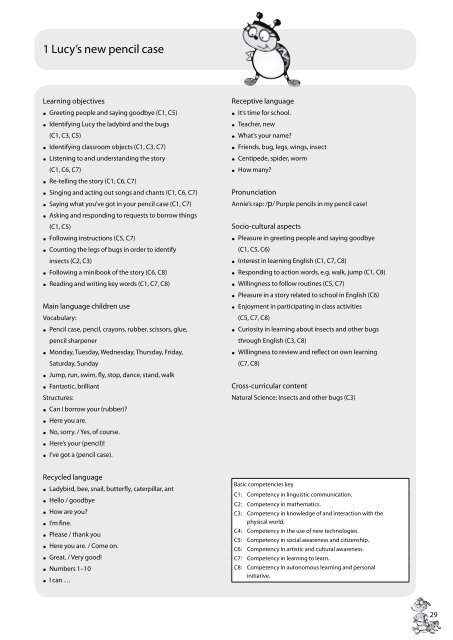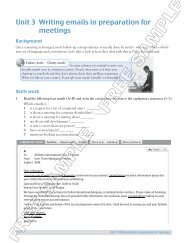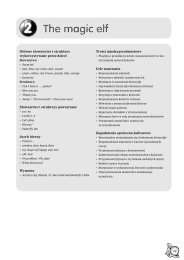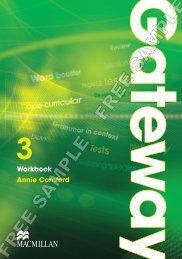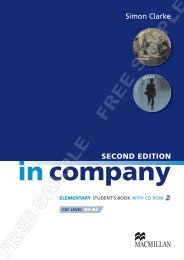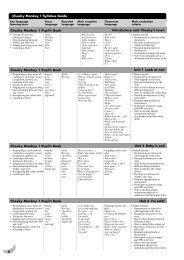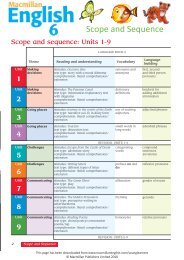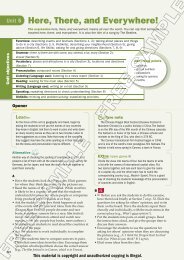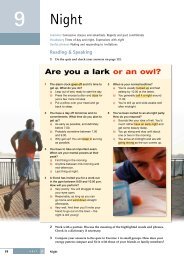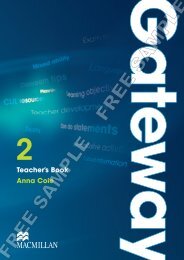1 Lucy's new pencil case - Macmillan
1 Lucy's new pencil case - Macmillan
1 Lucy's new pencil case - Macmillan
Create successful ePaper yourself
Turn your PDF publications into a flip-book with our unique Google optimized e-Paper software.
1 Lucy’s <strong>new</strong> <strong>pencil</strong> <strong>case</strong>Learning objectives• Greeting people and saying goodbye (C1, C5)• Identifying Lucy the ladybird and the bugs(C1, C3, C5)• Identifying classroom objects (C1, C3, C7)• Listening to and understanding the story(C1, C6, C7)• Re-telling the story (C1, C6, C7)• Singing and acting out songs and chants (C1, C6, C7)• Saying what you’ve got in your <strong>pencil</strong> <strong>case</strong> (C1, C7)• Asking and responding to requests to borrow things(C1, C5)• Following instructions (C5, C7)• Counting the legs of bugs in order to identifyinsects (C2, C3)• Following a minibook of the story (C6, C8)• Reading and writing key words (C1, C7, C8)Main language children useVocabulary:• Pencil <strong>case</strong>, <strong>pencil</strong>, crayons, rubber, scissors, glue,<strong>pencil</strong> sharpener• Monday, Tuesday, Wednesday, Thursday, Friday,Saturday, Sunday• Jump, run, swim, fly, stop, dance, stand, walk• Fantastic, brilliantStructures:• Can I borrow your (rubber)?• Here you are.• No, sorry. / Yes, of course.• Here’s your (<strong>pencil</strong>)!• I’ve got a (<strong>pencil</strong> <strong>case</strong>).Recycled language• Ladybird, bee, snail, butterfly, caterpillar, ant• Hello / goodbye• How are you?• I’m fine.• Please / thank you• Here you are. / Come on.• Great. / Very good!• Numbers 1–10• I can …Receptive language• It’s time for school.• Teacher, <strong>new</strong>• What’s your name?• Friends, bug, legs, wings, insect• Centipede, spider, worm• How many?PronunciationAnnie’s rap: /p/ Purple <strong>pencil</strong>s in my <strong>pencil</strong> <strong>case</strong>!Socio-cultural aspects• Pleasure in greeting people and saying goodbye(C1, C5, C6)• Interest in learning English (C1, C7, C8)• Responding to action words, e.g. walk, jump (C1, C8)• Willingness to follow routines (C5, C7)• Pleasure in a story related to school in English (C6)• Enjoyment in participating in class activities(C5, C7, C8)• Curiosity in learning about insects and other bugsthrough English (C3, C8)• Willingness to review and reflect on own learning(C7, C8)Cross-curricular contentNatural Science: Insects and other bugs (C3)Basic competencies keyC1: Competency in linguistic communication.C2: Competency in mathematics.C3: Competency in knowledge of and interaction with thephysical world.C4: Competency in the use of <strong>new</strong> technologies.C5: Competency in social awareness and citizenship.C6: Competency in artistic and cultural awareness.C7: Competency in learning to learn.C8: Competency in autonomous learning and personalinitiative.29
2 Let’s play, Tanya!Learning objectives• Identifying free time activities (C1, C6, C8)• Saying what you want to do (C1, C8)• Listening to and understanding the story(C1, C6, C7)• Re-telling the story (C1, C6, C7)• Singing and acting out songs and chants (C1, C6, C7)• Identifying colours (C1, C6)• Making and responding to suggestions (C1, C6, C8)• Following instructions (C5, C7)• Reading and writing key words (C1, C7, C8)• Identifying activities which are good exercise(C5, C8)• Acting out a role play (C1, C6, C8)• Identifying activities from sounds (C3, C6, C8)• Responding to instructions (C1, C7, C8)Main language children useVocabulary:• Play football / cards / a board game / a computergame, watch TV, listen to music• Pink, black, white• Screen, mouse• ExerciseStructures:• I want to (watch TV) / Me too!• Yes, great idea! / No, not now!• Open the /Close the door, window, book, your eyes• Come on everyone!• Click on …. Press enter.• This is fantastic!•Recycled language• Let’s …• Hello, goodbye• Yes, no• Please, thank you• Days of the week• Red, yellow, blue, green, orange, purple, brown• Play, sing, dance, run, walk, swimRide a bike• It’s fun• Days of the week• Numbers 1–5Receptive language• Later … / So …• Your score is ten.• Game over. Exit now.• It’s time to go home!• Alright. / Just for a minute.• What colour is it?PronunciationAnnie’s rap: /v/ and /b/ A very big bee on TV. A verybig bee looking at me!Socio-cultural aspects• Empathy with the characters in the story (C5, C6)• Pleasure in talking about free time activities inEnglish (C1, C6, C7)• Confidence in expressing personal opinions(C1, C5, C6)• Respect for the opinions of others (C5, C6)• Interest in identifying activities which are goodexercise in English (C5, C6, C8)• Interest in computers and technology (C4)• Willingness to review and reflect on own learning(C7, C8)Cross-curricular content• P.E.: ExerciseBasic competencies keyC1: Competency in linguistic communication.C2: Competency in mathematics.C3: Competency in knowledge of and interaction with thephysical world.C4: Competency in the use of <strong>new</strong> technologies.C5: Competency in social awareness and citizenship.C6: Competency in artistic and cultural awareness.C7: Competency in learning to learn.C8: Competency in autonomous learning and personalinitiative.59
Review Units 1 and 2: Rainy dayMy world, your world: Rainy day gamesLearning objectives•Identifying Lucy the ladybird and the bugs(C1, C3, C5)• Identifying classroom objects (C1, C3, C7)• Identifying free time activities (C1, C6, C8)• Asking and responding to requests to borrow things(C1, C5)• Making and responding to suggestions (C1, C6, C8)• Listening to and understanding the story(C1, C6, C7)• Learning about rainy day games in the UK (C5, C6)• Associating pictures with meaning (C1, C6, C7)• Reviewing and reflecting on learning (C7, C8)• Reading and writing key words (C1, C7, C8)Main language children useVocabulary:• Pencil <strong>case</strong>, <strong>pencil</strong>, crayons, rubber, <strong>pencil</strong> sharpener,scissors, glue• Play football / cards / a board game / a computergame, watch TV, listen to music• FantasticStructures:• Can I borrow your … ?• Let’s play …• I want to …• Not now.Recycled language• Pencil <strong>case</strong>, <strong>pencil</strong>, crayons, rubber, <strong>pencil</strong> sharpener,scissors, glue• Play football / cards / a board game / a computergame, watch TV, listen to music• Caterpillar, snail, bee, ladybird, butterfly, ant• Welcome back!• Where’s … ?• I don’t know• No, thank you.• It’s raining• Days of the weekReceptive language• Rainy day games• Ludo• Snakes and Ladders• Dominoes• Play cardsSocio-cultural aspects• Interest in learning English (C7, C8)• Pleasure in a story about rainy day games (C6, C7)• Positive attitude towards own ability to participatein class activities (C5, C7, C8)• Curiosity in learning about games in othercountries (C5, C6)• Enjoyment in completing activities in the book(C7, C8)• Willingness to review and reflect on own learning(C7, C8)Basic competencies keyC1: Competency in linguistic communication.C2: Competency in mathematics.C3: Competency in knowledge of and interaction with thephysical world.C4: Competency in the use of <strong>new</strong> technologies.C5: Competency in social awareness and citizenship.C6: Competency in artistic and cultural awareness.C7: Competency in learning to learn.C8: Competency in autonomous learning and personalinitiative.87
3 The moon is in the riverLearning objectives• Identifying farm animals (C1, C3, C8)• Listening to and understanding the story(C1, C6, C7)• Re-telling the story (C1, C6, C7)• Singing and acting out songs and chants (C1, C6, C7)• Counting to twenty (C2)• Asking and saying where you’re going (C1, C8)• Asking and saying if someone can come with you(C1, C8)• Understanding how the earth and moon move (C3)• Identifying things in the sky (C3)• Following a minibook of the story (C6, C8)• Following instructions (C5, C7)• Reading and writing key words (C1, C7, C8)Main language children useVocabulary:• Sheep, duck, cow, hen, horse, cat• Farm, boat, river, row• Get• There’s a …• Moon, stars, earth, planet, rocket, sun• Numbers 11–20Structures:• It’s cold (hot/sunny/cloudy/raining) today.• Where are you going? I’m going to (get a boat).• Can I come with you? Yes, of course.• On the farm• … by the river• Poor (cow)!ReceptiveRecycled language• Hello, goodbye, yes, no• Oh dear• Let’s …• Are you ready?• Stand up, walk• Big, small• Numbers 1–10• Days of the week• There’s a …• I can see …language• Rescue, sky, earth• All the animals get into the boat / fall in the river• Coat, hatPronunciationAnnie’s rap: /iː/ Three green sheep all asleep!Socio-cultural aspects• Pleasure in a story about farm animals (C3, C6, C7)• Appreciation of humour in the story (C1, C5, C6)• Curiosity and interest in learning about things inthe sky in English (C3)• Enjoyment in movement and drama (C6, C7)• Willingness to take turns (C5)• Care in completing activities in the book (C7, C8)• Willingness to review and reflect on own learning(C7, C8)Cross curricular content• Science: Things in the skyBasic competencies keyC1: Competency in linguistic communication.C2: Competency in mathematics.C3: Competency in knowledge of and interaction with thephysical world.C4: Competency in the use of <strong>new</strong> technologies.C5: Competency in social awareness and citizenship.C6: Competency in artistic and cultural awareness.C7: Competency in learning to learn.C8: Competency in autonomous learning and personalinitiative.95
4 The old houseLearning objectives• Identifying rooms in a house (C1, C3, C8)• Suggesting where to go (C1, C8)• Asking and saying where people are (C1, C8)• Listening to and understanding the story(C1, C6, C7)• Re-telling the story (C1, C6, C7)• Singing and acting out songs and chants (C1, C6, C7)• Identifying places and activities (C1, C3, C8)• Identifying members of the family (C1, C5, C6)• Identifying pets and their food (C1, C3, C8)• Following instructions (C5, C7)• Acting out a role play (C1, C6, C8)• Reading and writing key words (C1, C7, C8)Main language children useVocabulary:• The old house, bedroom, bathroom, kitchen, livingroom, garden, garage• Family, grandma, grandpa• Hamster, rabbit, turtle, guinea pig• Fish, meat, fruit, vegetablesStructures:• I’m scared!• Is (Felix) in the (kitchen)?• This is my (mum).• Good idea.• I love you!ReceptiveRecycled language• Let’s go to…• Where’s …?• I’m …• I don’t know. Come on,• Go, love• Yes, no• Ears, eyes, teeth• Mum, dad, brother, sister, black cat, dog• Sad, happy• Days of the week• Numbers 1–3language• School, playground, dining room, classroom• Who’s in …?• What big …• Maybe• Windy, raining, lost• Play, eat, work• Help!• PetPronunciationAnnie’s rap: /tʃ/ Chocolate and chicken in the kitchen!Socio-cultural aspects• Enjoyment in the humour and scary nature of thestory (C1, C6)• Pleasure in talking about homes and families inEnglish (C1, C5, C6)• Awareness of the value of families (C5, C6)• Respect for differences between families (C5, C6)• Interest in learning about animals we keep as petsand their food in English (C3, C5)• Willingness to review and reflect on own learning(C7, C8)Cross-curricular content• Natural Science: Pets and what they eatBasic competencies keyC1: Competency in linguistic communication.C2: Competency in mathematics.C3: Competency in knowledge of and interaction with thephysical world.C4: Competency in the use of <strong>new</strong> technologies.C5: Competency in social awareness and citizenship.C6: Competency in artistic and cultural awareness.C7: Competency in learning to learn.C8: Competency in autonomous learning and personalinitiative.123
Review: Units 3 and 4: The shadow monsterMy world, your world: PetsLearning objectives• Identifying Lucy the ladybird and the bugs(C1, C3, C5)• Identifying members of the family (C1, C5, C6)• Identifying farm animals (C1, C3, C8)• Identifying rooms in a house (C1, C3, C8)• Listening to and understanding the story(C1, C6, C7)• Associating pictures with meaning (C1, C6, C7)• Reviewing and reflecting on learning (C7, C8)• Talking about and comparing pets in the UK(C1, C3, C6)• Reading and writing key words (C1, C7, C8)Main language children useVocabulary:• Lucy the ladybird• Mum, dad, brother, sister, grandma, grandpa• The old house, living room, bathroom, bedroom,kitchen, garage, garden• Sheep, cow, duck, horse, cat, hen, rabbit, dog• Pets• MonsterStructures:• There’s a … in the …• It’s bedtime• What’s that?Recycled language• Sheep, cat, horse, duck, hen, cow, rabbit, dog• Stars, moon, earth• The old house, kitchen, living room, bedroom,bathroom, garage, garden• Lucy the ladybird• I’m scared• Surprise• Days of the week• GoodnightReceptive language• … in the park• … at home• … in the garden• What’s your perfect pet?Socio-cultural aspects• Appreciation of humour in the story (C1, C5, C6)• Appreciation of helping others shown in the story(C5)• Curiosity in learning about pets in another country(C3, C6)• Confidence in own ability to use English in context(C1, C7, C8)• Interest in identifying what animals can do inEnglish (C3)• Willingness to take turns (C5)• Respect for others in the group (C5, C6)• Willingness to review and reflect on own learning(C7, C8)Basic competencies keyC1: Competency in linguistic communication.C2: Competency in mathematics.C3: Competency in knowledge of and interaction with thephysical world.C4: Competency in the use of <strong>new</strong> technologies.C5: Competency in social awareness and citizenship.C6: Competency in artistic and cultural awareness.C7: Competency in learning to learn.C8: Competency in autonomous learning and personalinitiative.149
5 Crocodile tearsLearning objectives• Identifying parts of the body (C1, C3)• Asking and saying what the matter is (C5, C8)• Asking people to come here (C1, C8)• Listening to and understanding the story(C1, C6, C7)• Re-telling the story (C1, C6, C7)• Singing and acting out songs and chants (C1, C6, C7)• Listening to and identifying ages (C1, C5)• Following instructions (C5, C7)• Following a minibook of the story (C6, C8)• Reading and writing key words (C1, C7, C8)Main language children useVocabulary:• Head, tooth, back, neck, tummy, ear …ache• Legs, arms• Crocodile, monkey, frog, mouse• Clever, smile• Numbers 15, 20• Baby, child, teenager, adultStructures:• What’s the matter?• I’ve got a (headache).• Come here, please.• I’m a (clever crocodile).• How old are you? I’m …Recycled language• I’ve got a(n) … / I’m …• Here’s … / This is my …• Help me. / Oh dear.• Come here, please!• Eyes, mouth, fingers, toes, nose• Delicious, hungry• Breakfast• Run, swim• Happy, sad, big, small• Numbers 1–10• Days of the week• TurtleReceptive language• Tickle• Goes near / … goes ‘snap’• … all the animals appear.• Centimetres, thumb• Measure, grow• Keep movingPronunciationAnnie’s rap: /t/ Ted the turtle likes cake. Ted theturtle’s got tummy ache!Socio-cultural aspects• Appreciation of humour in the story (C1, C5, C6)• Curiosity in the human body (C3)• Awareness of the way we grow and change (C3, C5)• Enjoyment in measuring and recording size (C2, C8)• Willingness to take turns (C5)• Interest in reading and writing in English (C7, C8)• Willingness to review and reflect on own learning(C7, C8)Cross-curricular content• Social Science: The way we grow and changeBasic competencies keyC1: Competency in linguistic communication.C2: Competency in mathematics.C3: Competency in knowledge of and interaction with thephysical world.C4: Competency in the use of <strong>new</strong> technologies.C5: Competency in social awareness and citizenship.C6: Competency in artistic and cultural awareness.C7: Competency in learning to learn.C8: Competency in autonomous learning and personalinitiative.155
6 The princess and the frogLearning objectives• Identifying meals and food (C5, C6)• Asking and saying what’s for different meals(C1, C8)• Asking and saying if you can have some (food)(C1, C7, C8)• Listening to and understanding the story(C1, C6, C7)• Re-telling the story (C1, C6, C7)• Singing and acting out songs and chants (C1, C6, C7)• Ordering the life of a frog (C3)• Identifying numbers and colours (C1, C2, C3)• Following instructions (C5, C7)• Acting out a role play (C1, C6, C8)• Reading and writing key words (C1, C7, C8)Main language children useVocabulary:• Toast, cereal, pizza, ice cream, bread, soup• Beautiful, croak• Princess, prince, palace, pond• Egg, tadpoleStructures:• What’s for breakfast / lunch / dinner?• I like … / I don’t like (the frog).• You’re my best friend!Recycled language• What’s the matter?• Can I have some, please?• I’m … / I like … / I want …• Here’s …• Yes, no, / please, thank you• Ball, frog, egg• Jump, swim, eat• Big, little• Colours• Numbers 1–20• BugsReceptive• Animals• Days of the weeklanguage• Dive, croak, falls in• Remember!• … suddenly appears• … you must be …• TailPronunciationAnnie’s rap: /s/ Snail eats soup and cereal!Socio-cultural aspects• Pleasure in a traditional story (C6, C7)• Curiosity in learning about the life of a frog (C3)• Awareness of the importance of keeping promises(C5, C6)• Recognition of the value of friends (C5, C6)• Pleasure in participating in English (C1, C7, C8)• Confidence in own ability to learn (C1, C8)• Willingness to review and reflect on own learning(C7, C8)Cross-curricular learning• Natural Science: The life of a frogBasic competencies keyC1: Competency in linguistic communication.C2: Competency in mathematics.C3: Competency in knowledge of and interaction with thephysical world.C4: Competency in the use of <strong>new</strong> technologies.C5: Competency in social awareness and citizenship.C6: Competency in artistic and cultural awareness.C7: Competency in learning to learn.C8: Competency in autonomous learning and personalinitiative.183
Review: Units 5 and 6: Tummy troubleMy world, your world: Breakfast, lunch and dinnerLearning objectives• Identifying parts of the body (C1, C3)• Identifying meals and food (C5, C6)• Asking and saying what the matter is (C5, C8)• Asking and saying what’s for different meals(C5, C8)• Listening to and understanding the story(C1, C6, C7)• Following instructions (C5, C7)• Associating pictures with meaning (C1, C6, C7)• Reviewing and reflecting on learning (C7, C8)• Reading and writing key words (C1, C7, C8)Main language children useVocabulary:• Ladybird, caterpillar, snail, ant• Breakfast, lunch, dinner• Toast, cereal, ice cream, pizza, soup, bread• Head, tummy, tooth, ear, neck, back• Princess, prince, frog, crocodileStructures:• I’ve got …ache• What’s the matter? He’s got a …ache• What’s for breakfast / lunch / dinner?• I don’t like … / I like …Recycled language• Ladybird, caterpillar, snail, ant• Toast, cereal, ice cream, pizza, soup, bread• Tummy, head, ear, neck, tooth, back• I’ve got …ache• Princess, prince, frog, crocodile• I’m hungry.• I like … / I don’t like …• I want …• Delicious• Happy, sad• Can I have …?• Kitchen• School• FantasticReceptive language• Welcome back!• Eggs• … with their family• Can you remember …• LunchboxSocio-cultural aspects• Pleasure in a story about the bugs and meals(C6, C7)• Pleasure in the humour of the story (C1, C5, C6)• Awareness of the way food effects health (C3)• Respect for differences in the food people eat forbreakfast, lunch and dinner (C5, C6)• Enjoyment in expressing personal opinions inEnglish (C1, C5)• Willingness to listen to and interact with others(C1, C5, C8)• Willingness to take turns (C5)• Confidence and pleasure in own ability toparticipate in English (C1, C8)• Pleasure in expressing feelings in English (C1, C5)• Willingness to review and reflect on own learning(C7, C8)Basic competencies keyC1: Competency in linguistic communication.C2: Competency in mathematics.C3: Competency in knowledge of and interaction with thephysical world.C4: Competency in the use of <strong>new</strong> technologies.C5: Competency in social awareness and citizenship.C6: Competency in artistic and cultural awareness.C7: Competency in learning to learn.C8: Competency in autonomous learning and personalinitiative.208
HalloweenLearning objectives• Identifying items associated with Halloween(C3, C6)• Saying and understanding the story chant(C1, C6, C7)• Acting out the story chant (C1, C6, C7)• Singing a Halloween dance (C1, C6, C7)Main language children useVocabulary:• Happy Halloween• Witch, house, hat, bat, cat• LivesStructures:• In a …• has got a …• with a …Recycled language• I’m a …• Big, small• Here!Receptive language• Are you ready?• Abracadabra!• Disguise, partySocio-cultural aspects• Pleasure in celebrating Halloween in English (C6)• Enjoyment in acting out a chant (C6, C8)Basiccompetencies keyC1: Competency in linguistic communication.C2: Competency in mathematics.C3: Competency in knowledge of and interaction with thephysical world.C4: Competency in the use of <strong>new</strong> technologies.C5: Competency in social awareness and citizenship.C6: Competency in artistic and cultural awareness.C7: Competency in learning to learn.C8: Competency in autonomous learning and personalinitiative.215
ChristmasLearning objectives• Identifying decorations to go on a Christmas tree(C3, C6)• Singing and acting out a Christmas song (C1, C6, C7)• Identifying pictures on a Christmas calendar(C6, C7)Main language children useVocabulary:• Tree, branches• Ball, card, bell, star• CalendarStructures:• How lovely…Recycled language• Christmas, present• Numbers 1–10Receptive language• Put the … on the …• The Christmas tree’s got …• Look and compareSocio-cultural aspects• Pleasure in celebrating Christmas in English (C6)• Enjoyment in decorating a Christmas tree (C6)• Interest in making a Christmas calendar(C6, C7, C8)Basic competencies keyC1: Competency in linguistic communication.C2: Competency in mathematics.C3: Competency in knowledge of and interaction with thephysical world.C4: Competency in the use of <strong>new</strong> technologies.C5: Competency in social awareness and citizenship.C6: Competency in artistic and cultural awareness.C7: Competency in learning to learn.C8: Competency in autonomous learning and personalinitiative.221
EasterLearning objectives•••Identifying items associated with Easter (C3, C6)Singing an Easter song (C1, C6, C7)Following instructions (C5, C7)Main language children useVocabulary:•Structures:••Easter egg / bunny / chickWhere’s the …It’s in the …Recycled language• Happy Easter!• Bathroom, bedroom, living room, kitchen, garden,garage• Numbers 1–4Receptive language• It’s Easter time• Let’s have some fun• Let’s find the eggsSocio-cultural aspects• Pleasure in celebrating Easter in English (C6)• Enjoyment in becoming familiar with traditionalEaster characters (C6, C7)Basic competencies keyC1: Competency in linguistic communication.C2: Competency in mathematics.C3: Competency in knowledge of and interaction with thephysical world.C4: Competency in the use of <strong>new</strong> technologies.C5: Competency in social awareness and citizenship.C6: Competency in artistic and cultural awareness.C7: Competency in learning to learn.C8: Competency in autonomous learning and personalinitiative.227


